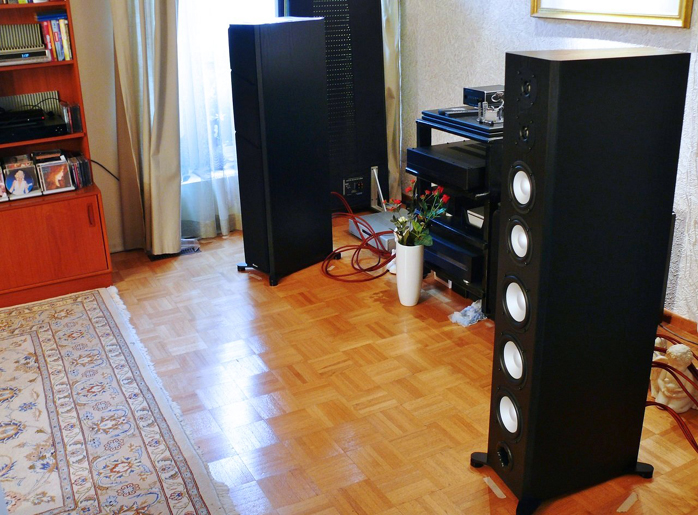This review page is supported in part by the sponsors whose ad banners are displayed below |
 |
 |
The big calling card of the LFR1100 is their omnipolar dispersion. The first priority was seeing whether they worked as advertised. Omnis and similar designs have a reputation for being difficult to set up due to room interaction becoming both friend and foe. With 11 drivers pumping in bipole motion, the big Axioms suggested a challenge. But how much?
|
 |
Acceptable performance was fairly easy to achieve but the LFR1100 did require good attention to detail to push to perfection. In my room it required being treated like my Apogee panels by optimizing for first arrival information and letting the rear enhance ambient information. Prior to fine tuning the speakers produced a huge soundstage with solidly anchored center fill that was virtually insensitive to listening position yet imaging lacked severe focus. Tweaking yielded improved placement precision and dimensionality that bore an uncanny resemblance to my Apogee Duetta. Yes there were differences (primarily the superior focus of the Apogee) but the LFR1100 was extremely close. Width, height, depth, image position and size were all eerily similar.
Stage width was wall to wall with very accurate placement with recordings that contained proper spatial cues. The LFR1100 were also adept at producing what panel owners call off-the-panel imaging. Instruments would generally appear behind or in front of the speaker. Initially depth and projection showed a monitor-style forward perspective with depth following suit proportionally. This evolved into a sophisticated huge soundstage with pronounced layering and good image focus in a large listening window that remained stable over both width and height. The 22 drivers presented a remarkably singular wave from a distance of roughly a foot away, with even response within that immense listening window. There was a small amount of on-axis dominance but this served to establish proportional image size and tighten focus. The recreation of space depended on recordings and had best results with purist fare. The LFR1100 also proved quite forgiving on competent multi-microphone efforts. This encompassed the majority of popular productions, making this particular omni compatible and enjoyable with a broad range music. With the omni aspects covered, how did the designers do otherwise?
|
|
|
Bass was quick, clean and articulate down to below 30 cycles and just a bit shy of true subsonic turf. For those wanting to dive deeper, Axiom has a broad selection of subwoofers. Dynamic impact was good out of the box and became even more robust over the break-in period. It was unobtrusive but capable of real power and kick when the material called for. Enthusiastic but well controlled. The midband was extremely well integrated with the bass and like its woofer counterpart quick, clean and articulate. The major break-in change was an evolution from being overly polite to considerably more enthusiastic. The dynamic abilities were initially outpaced by the tweeter but once the midrange drivers gained dynamic legs, the match was almost seamless.
The treble was smooth with very wide dynamic range and quick response. Once run in, the tonal balance was midrange-centric with the tweeters drawing virtually no individual attention. No metallic bite here. Top to bottom the speaker was singular with a mild tendency towards lower midrange warmth and a slightly soft top end in absolute terms. This afforded the speaker a natural rather than analytical perspective that focused on musical performance over microscopic analysis.
|
 |
On dynamics the LFR is a large multi-driver floorstander capable of beaucoup air movement but it also requires a touch of power to sing with beauty. It managed respectable low-level performance but fell just short of pricier benchmarks. Once it hit its minimal requirements, it shone. Where the LFR1100-HP excelled above its budget sibling was in sophistication and gradation. Here it achieved a much wider palette drawn on its much larger omni canvas. With good efficiency and swell driver artillery it maintained dynamic integrity over a broad range with remarkably low distortion. Where some audiophile speakers are apologetically reserved, the Axiom was capable of being quite immodest without changing character. Full spectrum dynamics were no issue, just load up on power. That relative lack of dynamic compression was a double-edged sword. The LFR was painfully revealing of recorded compression but would deftly soar on uncompressed music where it had the muscle and sophistication to make real use of the additional range.
|
|
|
|
|
On transient attack and decay the floorstander was very good but not quite as fast as speakers dedicated to those traits. Where the designers did well is balancing the speaker so that its abilities are uniform and don’t distract by emphasis. Resolution follows suit, giving up some absolutes but retaining enough to keep the complexity of the music intact and engaging. The contribution of the XLR DSP1100 was impossible to assess since it couldn't be bypassed. The boundary switch was effective when I experimented but not required for my room.
The sum of these parts is that Mr. Colquhoun and Mr. Welker have produced a speaker system which goes for refinement in tonal balance, very wide dynamic range and low distortion. Add to that a well-focused immense soundstage and a slight softening in transient behavior and one remains outside the extreme transparency camp to be firmly on the musical enjoyment side. The big Axiom plays it big, brawny and engaging.
|
 |
  |
 |
|